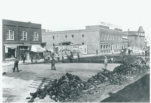Automated Traffic Enforcement not a cash grab, says LPS chief
By Alejandra Pulido-Guzman - Lethbridge Herald on September 10, 2024.
LETHBRIDGE HERALDapulido@lethbridgeherald.com The Lethbridge Police Service and the City of Lethbridge have responded to proposed changes to Automated Traffic Enforcement (ATE) program brought up by the province of Alberta.The proposed changes include the use of photo radar and intersection safety devices like red light cameras across the province.
According to a press release from LPS, those changes include banning cameras on all intersections, banning cameras on provincial highways and roads that connect them and only using cameras for playgrounds, schools and construction zones.
LPS Chief Shahin Mehdizadeh said Monday afternoon ATE devices help LPS to keep drivers accountable and removing them will be a big mistake.
“ATE devices provide the use of technology and innovation to monitor traffic offences and being able to hold people accountable for when they are infracting those offences such speeding and running through red lights,” said Mehdizadeh.
He added that some intersections across the city have cameras that help control both speed and red light compliance, and there is also the use of photo radar vehicles that are deployed on a regular basis.
“Every time we do that it is communicated to the public as of where it’s going to be to make sure people slow down,” said Mehdizadeh.
He said one thing that needs to be cleared up is where the money goes that is collected from traffic infractions caught on camera, as there seems to be a misunderstanding about it.
“I want to make sure that I highlight the fact that none of the money that is raised from the ATE program in this city comes to the police. Unlike other municipalities all the money goes split 40-60 split between the province and the city,” said Mehdizadeh.
He said the rumours that the ATE program is a money-grabbing initiative for the police are not true.
The concern raised by these potential changes stems from the fact that the City of Lethbridge has continued to grow exponentially.
Adding new ATE sites to high-risk areas is already prohibited by the provincial freeze implemented in 2019 and these proposed changes would see a further decrease to ATE sites, despite many requests from the public that more be done to address high risk areas where drivers’ habits need to be addressed to ensure the safety of residents.Â
Mayor Blaine Hyggen explained what the money is used for once it is collected while highlighting that safety for all members of the community is the city’s priority.
“The dollars that come from photo radar does come to the City. It goes into safety measures. It goes into signage and different safety initiatives within our community,” said Hyggen.
He added that the revenue is basically being collected from those who do not obey the traffic rules and they seem to be the ones wanting the ATE devices gone, contrary to what other citizens have expressed to him through emails, calls and in-person comments.
“Many of the calls, emails, texts, etc. that I get have one theme in common, people wanting to see more of them (ATE devices). I know some people say, well that’s hard to believe,” said Hyggen.
 He said to that he has a response that sometimes sounds a little bit harsh, but it has to be said.
 “The best way to not get a ticket is to not speed or to not go through a red-light camera. This is the law,” said Hyggen. 3
-2




